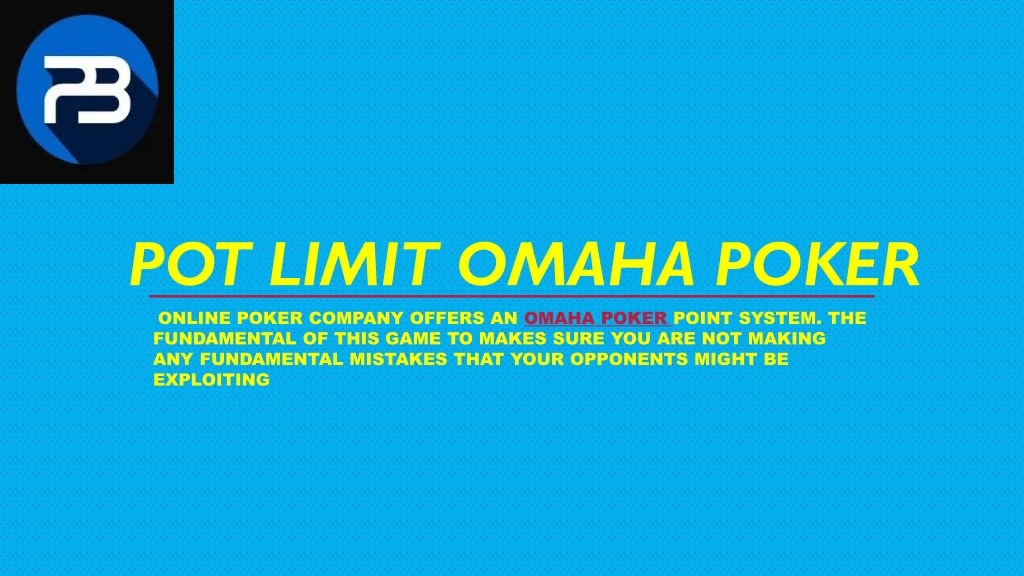Pot Limit Omaha Play Free
Dylan Weisman is a professional poker player and coach who has played Pot Limit Omaha for over a decade. To prove how lucrative low stakes PLO games are, Dylan successfully completed a $25,000 Bankroll Challenge in which he turned $5,000 into $25,000 in just 30 sessions. During the challenge, Dylan learned of the difficulties that relatively new PLO players deal with in their games and wanted. Pot-limit Omaha (frequently shortened to PLO) is popular in Europe, online, and in high-stakes 'mixed games' played in some American casinos. This variant is more often played high only, but can also be played high-low. To a still greater degree than in Limit Omaha Hi-Lo, PLO is a game of drawing, when drawing, to the nut hand. Pot Limit Omaha is commonly called “PLO”, and is the second-most popular poker game in the world, behind Texas Hold’em. Omaha is played using the buttons and blinds system seen in many other poker variants. For more on how this system works, check out our guide to Blinds, Antes & The Button.
Rules of Omaha

Pot-limit Omaha to the untrained eye looks similar to Texas hold em except that you start with four cards instead of the standard two. But this complex form of poker has many differences and it continues to grow in popularity as the poker boom matures.This book starts with the fundamentals of hand valuation and continues up through advanced concepts.
One key feature of Omaha begins with the deal. Instead of receiving 2 personal (hole) cards, each player in an Omaha game is dealt 4 hole cards to start the hand. Omaha is played with 5 community cards, just like Texas Hold’em. These are the flop (first 3 cards), turn (4th card) and river (5th card). There are four rounds of betting: before the flop, on the flop, on the turn and on the river.


After the last round of betting it is time for the showdown. If there are at least two players active, the one who shows the best 5 card poker hand wins the pot. However, in Omaha, each player must use exactly 2 of his 4 hole cards and exactly 3 of the community cards in making a 5 card hand. This is one of the main differences with Texas Hold’em, where the player can choose how many hole cards he is going to use to make his hand – he can even choose not to use them at all.
Example:
The board shows and the hand is three-ways: K♥2♥9♥8♠7♥
Player 1: A♥Q♠J♠10♣
Player 2: 2♣2♦2♠3♠
Player 3: J♥10♥5♦5♣
In this hand Player 3 is our winner with a King high flush.
Player 1 has a Jack high straight for the second place.
Player 2 has the worst hand: a set of deuces.
In this scenario we may erroneously think Player 1 not only has a straight, but the nut flush too, and Player 2 might seem to have quads with his three hole cards. This is the point where many Omaha beginners make a mistake. Therefore, remember: each player must use EXACTLY two of his hole cards, no more, no less.
Pot Limit Omaha (PLO)
Omaha is mostly played using Pot Limit betting. This is the format we are going to teach in this Omaha series.
We are assuming that you have already mastered the basic poker principles, such as when to check, bet, call and raise.
The special feature of Pot Limit is that the bet size cannot exceed the size of the total pot. It can be confusing at first, but you will soon get used to calculating pot size. And if you want to raise a bet the maximum amount, you must first include the size of your call. Sound complicated?
Let’s take an example, before the flop:
Poker Free Omaha Pot Limit
The game is 1-2 PLO, meaning the blinds are 1 for the Small Blind (SB) and 2 for the Big Blind (BB). The first player to act calls the BB (2). What is the highest possible bet for the next player?
After a hypothetical call the pot will be 1 (SB) + 2 (BB) + 2 (first player’s call) + 2 (second player’s call). Therefore it is possible to call for 2 and raise an additional 7 (size of the pot). The maximum bet this player can make is 9.
Perhaps a little definition shall help us understand this concept: if there is a bet of 1 and a player on the table bets 3, then we can express this in two ways. We can say this is a raise to 3, since 3 is the total amount of the bet. We can also say this is a raise of 2, since 2 is what has been raised over the call of 1. That might sound difficult, but if it’s any consolation to you, on PokerStars you can see both the pot size and the maximum possible bet at all times.
Play Omaha online, free

Pot Limit betting is also sometimes used when playing Texas Hold’em, but the pots rarely get as big as in Omaha. The combinations with 4 hole cards (instead of 2) appear to increase your hand potential dramatically; that’s why Omaha players tend to invest money to see the flop with more hands. It is also the biggest risk to those who are migrating from Texas Hold’em to Omaha. In truth, you should be as selective when choosing Omaha hands as you are in Texas Hold’em.
In the next article we will discuss the different types of Omaha starting hands, their potential, and the pre-flop strategy you should use.
Free Omaha Games
Join us on our Discord channel.



